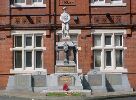
Newton-le-Willows and
Earlestown War Memorial

| OTHER WARS |
 |
Newton-le-Willows andEarlestown War Memorial |
 |
| The
Great War Roll of Honour |
|||||||||||||||||||||||||
Private Percy Foden was the son of Thomas and Dianah Foden of Thorn Bank, Golborne Road, Newton-le-Willows. Prior to enlisting, he had been a gardener to Mr. Randell, according to the obituary in the Warrington Guardian of 9th September 1916.
Percy had originally been reported as missing, but a letter to his mother in early September from Corporal Garland of the Royal West Kent Regiment stated that he had seen Private Foden's body in No Man's Land. "He died a noble death - fighting."
Percy was killed during the Battle of the Somme. The 4th Batallion
South Lancashire Regiment was a pionnering regiment whose job it was to dig
trenches and so on. Captain H. Whalley-Kelly, in his book “Ich Dien”,
gives an account of the circumstances in which Captain
Collingwood was killed and Percy Foden was one of "5 other ranks missing":
“On 7th August a local attack on Guillemont
village was made by troops of the 55th Division, (with whom Leo
Doyle of the 5th South Lancashires was fighting) and “D”
Company of the Battalion was attached to the 164th Infantry Brigade for the
operation. “D” Company was divided into two, the right half under
Captain C. Collingwood and the left under Second-Lieutenant G. C. Coury, working
in conjunction, respectively, with the 1st/8th King’s and 1st/4th King’s
Own. In each case the role of the Pioneer parties was to dig communication trenches
from the newly-captured positions back to our original line; a task involving
great risks, as the troops had to work in the open, swept by machine-gun and
shell fire.
“At 4.20 a.m. the attack went forward, closely followed by the two half
companies of the 1st/4th, their Lewis gunners providing local covering fire.
To describe the confused fighting that followed is outside the scope of this
chronicle, suffice it to say that the assault broke down, but not before the
right half company had constructed sixty yards of communication trench, while
the left half company had dug, in one hour, a hundred yards of trench five feet
deep; a magnificent effort on the part of “D” Company which cost
it 2 officers (including Captain Collingwood) and 6 other ranks killed, and
1 officer and 47 other ranks wounded, plus 5 other ranks missing.”